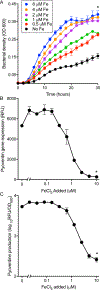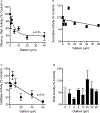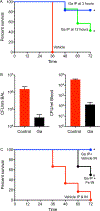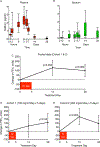Gallium disrupts bacterial iron metabolism and has therapeutic effects in mice and humans with lung infections
- PMID: 30257953
- PMCID: PMC6637966
- DOI: 10.1126/scitranslmed.aat7520
Gallium disrupts bacterial iron metabolism and has therapeutic effects in mice and humans with lung infections
Abstract
The lack of new antibiotics is among the most critical challenges facing medicine. The problem is particularly acute for Gram-negative bacteria. An unconventional antibiotic strategy is to target bacterial nutrition and metabolism. The metal gallium can disrupt bacterial iron metabolism because it substitutes for iron when taken up by bacteria. We investigated the antibiotic activity of gallium ex vivo, in a mouse model of airway infection, and in a phase 1 clinical trial in individuals with cystic fibrosis (CF) and chronic Pseudomonas aeruginosa airway infections. Our results show that micromolar concentrations of gallium inhibited P. aeruginosa growth in sputum samples from patients with CF. Ex vivo experiments indicated that gallium inhibited key iron-dependent bacterial enzymes and increased bacterial sensitivity to oxidants. Furthermore, gallium resistance developed slowly, its activity was synergistic with certain antibiotics, and gallium did not diminish the antibacterial activity of host macrophages. Systemic gallium treatment showed antibiotic activity in murine lung infections. In addition, systemic gallium treatment improved lung function in people with CF and chronic P. aeruginosa lung infection in a preliminary phase 1 clinical trial. These findings raise the possibility that human infections could be treated by targeting iron metabolism or other nutritional vulnerabilities of bacterial pathogens.
Copyright © 2018 The Authors, some rights reserved; exclusive licensee American Association for the Advancement of Science. No claim to original U.S. Government Works.
Figures








Similar articles
-
Colistin kills bacteria by targeting lipopolysaccharide in the cytoplasmic membrane.Elife. 2021 Apr 6;10:e65836. doi: 10.7554/eLife.65836. Elife. 2021. PMID: 33821795 Free PMC article.
-
Pseudomonas aeruginosa aggregates in cystic fibrosis sputum produce exopolysaccharides that likely impede current therapies.Cell Rep. 2021 Feb 23;34(8):108782. doi: 10.1016/j.celrep.2021.108782. Cell Rep. 2021. PMID: 33626358 Free PMC article.
-
Characterization of gallium resistance induced in a Pseudomonas aeruginosa cystic fibrosis isolate.Arch Microbiol. 2020 Apr;202(3):617-622. doi: 10.1007/s00203-019-01777-y. Epub 2019 Nov 26. Arch Microbiol. 2020. PMID: 31773196
-
Levofloxacin inhalation solution for the treatment of chronic Pseudomonas aeruginosa infection among patients with cystic fibrosis.Expert Rev Respir Med. 2015 Feb;9(1):13-22. doi: 10.1586/17476348.2015.986469. Epub 2014 Nov 24. Expert Rev Respir Med. 2015. PMID: 25417708 Review.
-
The problems of antibiotic resistance in cystic fibrosis and solutions.Expert Rev Respir Med. 2015 Feb;9(1):73-88. doi: 10.1586/17476348.2015.995640. Epub 2014 Dec 26. Expert Rev Respir Med. 2015. PMID: 25541089 Review.
Cited by
-
A pilot study of cystic fibrosis exacerbation response phenotypes reveals contrasting serum and sputum iron trends.Sci Rep. 2021 Mar 1;11(1):4897. doi: 10.1038/s41598-021-84041-y. Sci Rep. 2021. PMID: 33649353 Free PMC article.
-
pH-mediated potentiation of gallium nitrate against Pseudomonas aeruginosa.Front Microbiol. 2024 Sep 24;15:1464719. doi: 10.3389/fmicb.2024.1464719. eCollection 2024. Front Microbiol. 2024. PMID: 39380683 Free PMC article.
-
Biofilm Microenvironment Activated Antibiotic Adjuvant for Implant-Associated Infections by Systematic Iron Metabolism Interference.Adv Sci (Weinh). 2024 May;11(17):e2400862. doi: 10.1002/advs.202400862. Epub 2024 Feb 26. Adv Sci (Weinh). 2024. PMID: 38408138 Free PMC article.
-
Development of Biocompatible Ga2(HPO4)3 Nanoparticles as an Antimicrobial Agent with Improved Ga Resistance Development Profile against Pseudomonas aeruginosa.Antibiotics (Basel). 2023 Oct 30;12(11):1578. doi: 10.3390/antibiotics12111578. Antibiotics (Basel). 2023. PMID: 37998780 Free PMC article.
-
What Is New in the Anti-Pseudomonas aeruginosa Clinical Development Pipeline Since the 2017 WHO Alert?Front Cell Infect Microbiol. 2022 Jul 8;12:909731. doi: 10.3389/fcimb.2022.909731. eCollection 2022. Front Cell Infect Microbiol. 2022. PMID: 35880080 Free PMC article. Review.
References
-
- Flamm RK, Weaver MK, Thornsberry C, Jones ME, Karlowsky JA, Sahm DF, Factors associated with relative rates of antibiotic resistance in Pseudomonas aeruginosa isolates tested in clinical laboratories in the United States from 1999 to 2002. Antimicrob Agents Chemother 48, 2431–2436 (2004); published online EpubJul ( - PMC - PubMed
-
- Skovgaard N, New trends in emerging pathogens. Int J Food Microbiol 120, 217–224 (2007); published online EpubDec 15 ( - PubMed
-
- Stewart PS, Mechanisms of antibiotic resistance in bacterial biofilms. Int. J. Med. Microbiol. 292, 107–113 (2002). - PubMed
Publication types
MeSH terms
Substances
Grants and funding
LinkOut - more resources
Full Text Sources
Other Literature Sources
Medical

